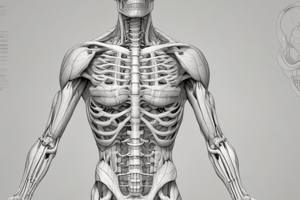Podcast
Questions and Answers
What are voluntary muscles characterized by?
What are voluntary muscles characterized by?
- Involuntary control over their contractions
- Being responsible for pumping blood
- Lining blood vessels and organs
- The ability to be consciously controlled (correct)
How do skeletal muscles primarily function in the body?
How do skeletal muscles primarily function in the body?
- By supplying blood to various systems
- By pushing bones to create movement
- By lining organs for movement
- By contracting and relaxing to pull on bones (correct)
Which of the following statements about cardiac muscles is true?
Which of the following statements about cardiac muscles is true?
- Cardiac muscle cells have no connection to each other
- They are found in all muscles of the body
- They can tire easily during prolonged activity
- They are involuntary and do not need conscious control (correct)
What role do smooth muscles play in the body?
What role do smooth muscles play in the body?
What happens to skeletal muscles when a person exercises regularly?
What happens to skeletal muscles when a person exercises regularly?
What is the primary function of skeletal muscles?
What is the primary function of skeletal muscles?
Which statement accurately describes tendons?
Which statement accurately describes tendons?
Why do skeletal muscles require a rich blood supply?
Why do skeletal muscles require a rich blood supply?
What occurs as a result of rapid muscle contractions during shivering?
What occurs as a result of rapid muscle contractions during shivering?
Which of the following is NOT a function of skeletal muscles?
Which of the following is NOT a function of skeletal muscles?
How do skeletal muscles contribute to temperature regulation?
How do skeletal muscles contribute to temperature regulation?
Which of the following statements about skeletal muscles is true?
Which of the following statements about skeletal muscles is true?
What type of muscle covers and protects internal organs?
What type of muscle covers and protects internal organs?
What is the primary function of muscle tissue?
What is the primary function of muscle tissue?
Which type of muscle is described as being spindle-shaped with a wider belly?
Which type of muscle is described as being spindle-shaped with a wider belly?
What is a characteristic of pennate muscles?
What is a characteristic of pennate muscles?
Which muscle type is known for maximum force production due to its fiber arrangement?
Which muscle type is known for maximum force production due to its fiber arrangement?
Which example corresponds to a bipennate muscle?
Which example corresponds to a bipennate muscle?
What shape do circular muscles typically have?
What shape do circular muscles typically have?
What distinguishes unipennate muscles from other muscle types?
What distinguishes unipennate muscles from other muscle types?
Which of the following is NOT a characteristic of parallel muscles?
Which of the following is NOT a characteristic of parallel muscles?
Flashcards are hidden until you start studying
Study Notes
Muscle Definition and Function
- Muscles consist of strong tissue capable of orderly contraction, composed of muscle cells.
- Muscle contractions shorten the tissue, while relaxation returns them to their original length.
Muscle Shapes
- Circular Muscles: Sphincter muscles surrounding openings, e.g., Orbicularis Oris (mouth) and Orbicularis Oculi (eyes).
- Convergent Muscles: Have a wider origin than insertion, allowing for maximum force, e.g., Pectoralis Major.
- Parallel Muscles: Fibers run parallel, leading to large movements and good endurance but less strength, commonly referred to as strap muscles.
- Fusiform Muscles: Spindle-shaped with a wider belly than origin and insertion, e.g., Biceps Brachii and Psoas Major.
- Pennate Muscles: High fiber density offers strength but less endurance. Divided into:
- Unipennate: Diagonal fiber arrangement to a tendon, e.g., Lumbricals and Extensor Digitorum.
- Bipennate: Two rows of fibers in opposite directions around a central tendon, e.g., Rectus Femoris.
- Multipennate: Multiple rows of diagonal fibers with branching tendons, e.g., Deltoid muscle.
Skeletal Muscles
- Over 600 skeletal muscles in the human body, varying greatly in size.
- Each muscle consists of numerous fibers bundled together and wrapped in connective tissue, aiding in support, protection, and providing pathways for nerves and blood vessels.
- Skeletal muscles require a rich blood supply for oxygen and nutrient delivery, also responsible for waste removal.
Functions of Muscular System
- Movement: Skeletal muscles attached to bones enable body movement, varying in speed from quick running to slow stretching.
- Stability: Muscles support the body and maintain balance, with tendons connecting muscles to bones and stabilizing joints.
- Protection: Muscles serve as padding, covering the skeleton and internal organs, protecting them from injury.
- Temperature Regulation: Muscle contractions, such as shivering, convert chemical energy into thermal energy, maintaining body temperature around 37°C.
Types of Muscles
- Skeletal Muscles: Voluntary muscles attached to bones, enabling conscious control, capable of rapid and powerful contractions but can tire quickly.
- Cardiac Muscles: Involuntary muscles found only in the heart, pumping blood through coordinated contractions, characterized by branched cells with signal-discs.
- Smooth Muscles: Involuntary muscles lining blood vessels and organs, facilitating movement of materials, such as food through the digestive system and regulating blood flow.
Studying That Suits You
Use AI to generate personalized quizzes and flashcards to suit your learning preferences.




